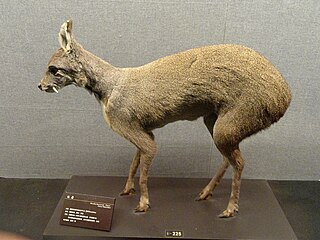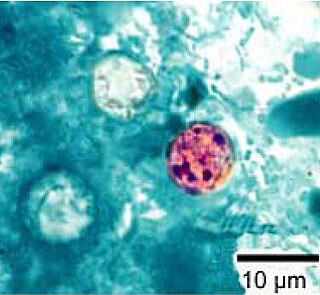
Eimeria is a genus of apicomplexan parasites that includes various species capable of causing the disease coccidiosis in animals such as cattle, poultry and smaller ruminants including sheep and goats. Eimeria species are considered to be monoxenous because the life cycle is completed within a single host, and stenoxenous because they tend to be host specific, although a number of exceptions have been identified. Species of this genus infect a wide variety of hosts. Thirty-one species are known to occur in bats (Chiroptera), two in turtles, and 130 named species infect fish. Two species infect seals. Five species infect llamas and alpacas: E. alpacae, E. ivitaensis, E. lamae, E. macusaniensis, and E. punonensis. A number of species infect rodents, including E. couesii, E. kinsellai, E. palustris, E. ojastii and E. oryzomysi. Others infect poultry, rabbits and cattle. For full species list, see below.

The dwarf musk deer or Chinese forest musk deer is an artiodactyl native to southern and central China and northernmost Vietnam. The species name is after the collector Mikhail Mikhailovich Berezovsky. On June 14, 1976, China entered the dwarf musk deer onto its endangered species list. Four subspecies are recognized:

The round-tailed ground squirrel, known as "Ardillón cola redonda" in Spanish, live in the desert of the Southwestern United States and Northwestern Mexico. They are called "ground squirrels" because they burrow in loose soil, often under mesquite trees and creosote bushes.
Bobby Witcher (1916–1966) was an American herpetologist best known for his carefree handling of venomous snakes.
Eimeria fraterculae is a species of alveolates belonging to the family Eimeriidae. It causes renal coccidiosis in the Atlantic puffin.
Eimeriorina is a suborder of phylum Apicomplexa.

Eimeriidae is a family of Apicomplexa. It contains the following genera:
Eimeria kinsellai is an apicomplexan parasite of the genus Eimeria that infects the marsh rice rat. It was discovered in 1970 at Paynes Prairie, Alachua County, Florida. A different Eimeria, Eimeria palustris, has been found in Alabama marsh rice rats. E. kinsellai differs from other Eimeria found in rice rats, such as Eimeria couesii, Eimeria oryzomysi, Eimeria ojastii, and E. palustris, in anatomical details. It was named after parasitologist John M. Kinsella.
Eimeria palustris is an apicomplexan parasite of the genus Eimeria that infects the marsh rice rat. It was discovered in 1970 at Tuskegee National Forest, Macon County, Alabama. A different Eimeria, Eimeria kinsellai, has been found in Florida marsh rice rats. E. palustris differs from other Eimeria found in rice rats, such as Eimeria couesii, Eimeria oryzomysi, Eimeria ojastii, and E. kinsellai, in anatomical details. Its specific epithet refers to that of its type host, Oryzomys palustris.
Eimeria couesii is an apicomplexan parasite of the genus Eimeria that infects the intestine of the rice rat Oryzomys couesi in Mexico. It has an oocyst residuum and Stieda bodies, structures that are absent in some other Eimeria.
Choleoeimeria is a genus of alveolate parasites that infect the biliary tracts of reptiles. Morphologically they are similar to the Eimeria, to whom they are closely related. The genus was described in 1989 by Paperna and Landsberg.
Acroeimeria is a genus of parasites that contains those species which initially develop immediately beneath the brush-border of the intestinal epithelium, but the meronts and gamonts of which are early on extruded to form a layer on the surface of the gut mucosa. Morphologically they are similar to the Eimeria to which they are closely related. The genus was described in 1989 by Paperna and Landsberg.
Goussia is a taxonomic genus, first described in 1896 by Labbé, containing parasitic protists which largely target fish and amphibians as their hosts. Members of this genus are homoxenous and often reside in the gastrointestinal tract of the host, however others may be found in organs such as the gallbladder or liver. The genera Goussia, as current phylogenies indicate, is part of the class Conoidasida, which is a subset of the parasitic phylum Apicomplexa; features of this phylum, such as a distinct apical complex containing specialized secretory organelles, an apical polar ring, and a conoid are all present within Goussia, and assist in the mechanical invasion of host tissue. The name Goussia is derived from the French word gousse, meaning pod. This name is based on the bi-valve sporocyst morphology which some Goussians display. Of the original 8 classified Goussians, 6 fit the “pod” morphology. As of this writing, the genera consists of 59 individual species.

Cyclospora is a genus of apicomplexan parasites. It includes the species Cyclospora cayetanensis, the causative agent of cyclosporiasis. Members of Cyclospora are characterized as having oocysts with two sporocysts, each containing two sporozoites.
Calyptospora is a genus of parasitic protozoa in the phylum Apicomplexa.
Dorisa is a genus of parasitic alveolates in the phylum Apicomplexa.
Epieimeria is a genus of parasitic alveaolates of the phylum Apicomplexa.
Pythonella is a genus of parasitic alveolates belonging to the phylum Apicomplexa. This genus was created by Ray and Das-Gupta in 1937.
Margolisiella is a genus of parasitic alveolates belonging to the phylum Apicomplexa.
Lankesterella is a genus in the phylum Apicomplexa. Species in this genus infect amphibians, reptiles and birds.




